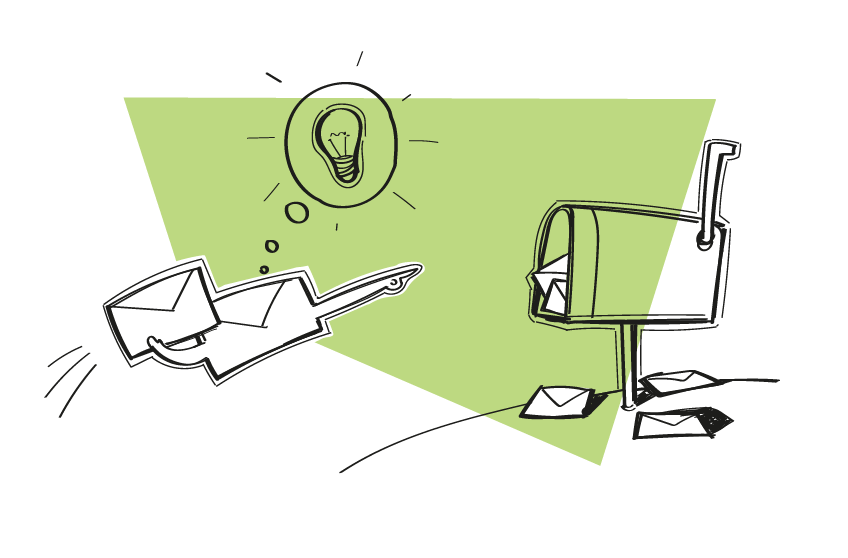A couple of weeks ago Cathy, our CGO and founder of the Woodpecker blog, got a cold email.
Big news, right? She gets lots of cold emails
Mostly bad cold emails.
But the initial email this time was good.
And so were the follow-ups.
In fact, Cathy liked them so much that she asked the sender, Nick from Linkio, if he wanted to collect and share his tips for writing effective follow-ups in a guest post.
So, ladies and gentlemen, here it is – a collection of practical tips and real-life examples for how to write a follow-up if you haven’t heard back, courtesy of Nick Campbell.
***
The fact is that even with a great value proposition, a promise of immediate value, a clear call to action and a killer subject line, you’re unlikely to get amazing results with your first pitch. People live their lives on the other side of your outreach funnel. Even your target audience may not respond positively to your message.
Spam filters can get in the way, your request for a quick chat can be ignored or the people you thought were your potential clients really aren’t — there’s a lot that can keep you away from your desired outcome of starting an initial conversation.
That’s why need follow-up emails, to try again to change prospects from indifferent to interested and move them closer to a discovery call, in-person conversation or other goal.
There’s nothing wrong with sending follow-up emails. It’s a standard and familiar practice for everyone involved. As a sender, it gives you another chance to start that conversation or share a gentle reminder. For prospects, follow-up emails often serve as a helpful reminder email since people are busy and emails can fall through the cracks and disappear from your mental radar.
Follow-up emails work for both sides.
But just like everything else, there are some important do’s and don’ts when deciding how to write follow-up emails. Doing it well can make that connection with a potential client. Taking the wrong approach in your follow-up message can make an email recipient permanently block you from their inbox.
Let’s look more closely at how you can use follow-ups to support the goals of your original email.
The path to your first follow-up
We all know the feeling of putting together a great email, hitting “Send”, letting a reasonable waiting period pass and…nothing.
Ok, maybe not “nothing” but definitely not what you expected. You dared to hope for more but the reality brings you back to Earth.
That’s ok, we’ve all be there. The important point, however, is just to remember that your first email message was just the opening move in a chess match, not the only move. You have to go into each campaign expecting to use follow-up emails to get your message across.
So your first follow-up email is really just an extension of your original message. But when returning to a recipient after you send an email with no response, make sure you approach it with the right mindset.
No matter how frustrated you are at the lack of a response, you can’t start your follow-up like a complaint, or worse still, an accusation of them ignoring your pitch. I once received an email where a guy emphasized that I kept him waiting for two weeks. It’s just a bad tone, especially since I didn’t owe him anything.

This is the kind of tone you might take in an email about an unpaid invoice, not when you’re trying to start a conversation.
Try to come up with a tactful way to phrase your reminder. For example, you can ask nonrespondents if they need more time to consider your offer. Since everyone is busy, show respect for their time. Make it clear that you look forward to hearing from then whenever they can get back to you. As long as your contact info is there, they know where to find you.

Another adjustment that brings me replies is telling people that I’m ready to play by their rules. Make it clear that you’ll adapt yourself to their schedules, not vice versa. This is an important step towards possible cross-promotion.

What to say in a follow-up email after no response
There’s no way you can know for sure why your previous email went nowhere. Some prospects were probably busy, others were not interested for whatever reason. Remember that it’s possible that some recipients didn’t find you credible enough to consider further collaboration. That means that if you don’t add anything new to the original message in your follow-up, you’re basically trying the same thing again while expecting a different result.
That means changing the formula somehow and trying a different angle. Don’t use the same subject line, be sure you’re addressing a prospect pain point, include key details that can stimulate interest in learning more, and if reaching out to an organization be sure you’re writing to the right person.
There are lots of little ways to make sure your follow-up message is different enough from your original email.
Use your follow-up to set a tone of authority for your brand. For example, you can mention a big company name that you’ve worked with before.

Don’t have an impressive name on your client list? No problem. You can always shift focus and write about the benefits your clients have gained from working with you or maybe some feedback from them.

How to follow up with someone who hasn’t replied to multiple emails
So what about when your second follow-up email gets the same (non)result as your first message? Do you keep going? Do you give up?
When you decide to send follow-ups, you should set a limit on how far you will go. While there is no fixed rule about how many follow-up emails you can or should send, good practices say three or, at an absolute maximum, four is the magic number. This is a reasonable amount of contacts to give the prospect you want to share and to let them decide if they want to engage with you.
It is possible to send too many follow-ups. If you’re sending, say, your sixth email without a word in reply, you’re doing it wrong.
You can even endanger your ability to reach out via email if you follow up too many times. It can happen that a particular recipient who is tired of seeing your name in their inbox can simply mark one of your messages as spam. If enough people do that, you will have serious problems with deliverability and do real damage to your domain reputation.
If that ever happens to you, you’ll have much more serious things to think about than what you’re going to put in your next follow-up.
You don’t need to cross nonrespondents off your list for good. Just give them some rest. Then, in a few months, you can start over. Since they ignored you earlier, it makes no sense to send them a rephrased pitch about the same again. Here’s how Brian Dean, a cofounder of Exploding Topics, suggests following up over time.

Is it safe to use all follow-up email templates shared online?
There’s no shortage of free follow-up templates that will ease the job for you. But not all of them are worth a try. I occasionally stumble upon the so-called “break-up email,” e.g. #5 here. It’s like an unsubscribe button – you contact nonrespondents one last time and request their permission to remove them from your prospecting list 🙂

On the one hand, it lets you weed out people who wouldn’t accept your offer anyway and would only waste your time. But here comes the downside. If someone tells you not to bother them anymore, that’s the end of the line. You can’t email them with new offers later, at a better time for them.
Things can also change for you. If you do sales outreach, your software can get new features that other similar tools on the market lack. As for link outreach, your domain authority can grow over time, and influencers will be more willing to deal with you then after they assess SEO strength of your site.
I sent this breakup email to a few prospects once, and here’s what I got when I followed up with one of them in half a year.

You’d better use a lite version of this breakup email. Instead of telling people you’ll remove them from your list, ask them if they don’t mind you resending your offer elsewhere. A polite follow-up email can pay off in the long run.

Afterword
Now that you know how to write a follow-up email, do some A/B testing. These tricks brought me 24.49% of replies during my last outreach, but things can differ for you. Based on my advice and your tests, try to come up with a winning follow-up formula for peeps in your niche. You can then review the results in embedded dashboards.
Note that I shared screenshots of my follow-ups to illustrate my line of thought. Don’t re-use them as is, word for word, changing your prospect’s name only. If people start receiving identical follow-ups, it won’t take long for these tricks to stop working. Try to at least rephrase and personalize them to your case and prospect. It won’t hurt to use some data enrichment either.
***
Want to see how to send a follow-up email after getting no response? Go here>>
FAQ
What is a follow-up email template, and why is it useful?
A follow-up email template is a pre-designed format used to send follow-up emails efficiently. It is useful because it saves time, ensures consistency in messaging, and helps maintain a professional tone when reaching out to contacts after an initial email or meeting.
How can I write a strong subject line for a follow-up email?
To write a strong subject line for a follow-up email, make it clear, concise, and relevant. Include keywords that remind the recipient of the previous email or meeting. For example, “Following Up on Our Discovery Call” or “Next Steps After Our Meeting Request.”
What should be included in a follow-up email after a meeting request?
A follow-up email after a meeting request should include a personalized greeting, a brief recap of the meeting request, and any agreed-upon next steps. For instance, “It was a pleasure speaking with you about the upcoming project. Looking forward to our scheduled meeting next week.”
Can you provide a follow-up email example?
Certainly! Here is a follow-up email example:
Subject: Following Up on Our Discovery Call Hi [Recipient's Name],
It was a pleasure speaking with you during our discovery call. I wanted to follow up on the key points we discussed and outline the next steps.
[Briefly recap the discussion and any actions required.]
Looking forward to your feedback.
Best regards,
[Your Name]
[Company Name]
How important are subject lines in follow-up emails?
Subject lines are crucial in follow-up emails as they determine whether the recipient will open the email. A strong subject line grabs attention and provides context about the email’s content, increasing the likelihood of it being read.
How can a personalized greeting improve a follow-up email?
A personalized greeting makes the follow-up email feel more sincere and tailored to the recipient. Using the recipient’s name and referencing specific details from the previous email or meeting shows that you value the relationship and are attentive to their needs.
What should be highlighted in a follow-up email to significantly contribute to the conversation?
In a follow-up email, highlight key points from the previous email or meeting, any agreed-upon actions, and how you or your company can significantly contribute to the recipient’s needs or goals. This demonstrates your commitment and value to the ongoing conversation.
How can follow-up emails be used in email marketing?
In email marketing, follow-up emails can nurture leads, re-engage inactive customers, and maintain communication with potential clients. They should include a strong subject line, a personalized greeting, and content that addresses the recipient’s interests or previous interactions with your company.
Why is it important to briefly recap the previous email in a follow-up?
Briefly recapping the previous email in a follow-up is important because it reminds the recipient of the context and purpose of the ongoing conversation. This helps maintain continuity and ensures that both parties are on the same page regarding the discussed topics and next steps.
What are some effective email subject lines for follow-up emails?
Effective email subject lines for follow-up emails include:
-
-
- “Quick Follow-Up on Our Previous Email”
- “Next Steps After Our Discovery Call”
- “Following Up: [Meeting Request Details]”
- “Re: Our Recent Conversation on [Topic]”
-
READ ALSO

How Does Woodpecker Send Your Emails & Follow-ups?
“I have sent a test campaign from Woodpecker, but it looks like it sends the emails very slowly…,” said Till – one of our beta testers. He sounded disappointed. We were surprised that he saw it as a drawback. We didn’t realize that we see it as an advantage because we know exactly how Woodpecker works. Once we explained to Till how the emails are sent and why so, he found it very interesting and said that it would make a great topic for a blog post. So this one is for you, Till! ;) And for all of you who are not really sure how Woodpecker sends your emails and follow-ups, and why it works this way.

Sales Breakup Email – Why Would You Break Up with a Prospect?
Have you ever felt frustrated when prospects haven’t replied to your emails? You’ve put so much effort and time into writing a good email, you’ve picked an email automation tool that sends like a human to help you out with sending the messages, but some prospects are still unresponsive.

Woodpecker Academy – A 5-step Course To Help You Build a Successful Cold Email Campaign
We are pleased to announce that Woodpecker Academy is now live! We've released our first online course. After 6 years of creating content focused on cold emailing, we’ve decided to merge all the knowledge we've shared so far into a step-by-step workflow that will help you launch successful cold email campaigns.

